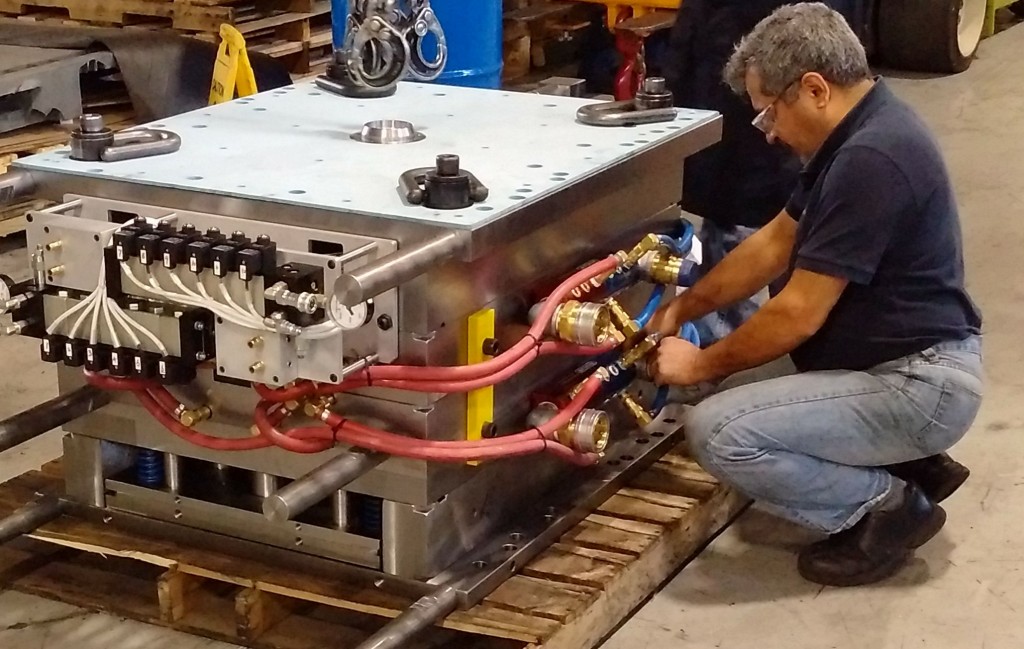
INTEX TOOLING TECHNOLOGIES is cutting into the market
Canadian Plastics
Canadian Plastics MoldmakingComing out of the Great Recession, Canada’s manufacturing sector looked like scorched earth after a massive forest fire. But scorched earth sometimes encourages new growth. In post-recession Southern Ontario, one group of entrepreneurs surveyed the landscape and saw opportunity. The result is Intex Tooling Technologies, a tooling supplier incorporated in 2012 and headquartered 30 miles north of Toronto in Aurora. “Our owners saw the need for a complete tooling and engineering services provider in the Greater Toronto Area, since so many tool shops in the region had gone out of business during the financial crisis,” said Mark Hoeflich, Intex’s senior business development manager. “It was a bold move at a time when very few startups were being established.”
Located in a 35,000-square-foot facility with over 25 employees, Intex offers tooling for both low and high-volume molds; complex sequentially valve-gated multi-cavity tooling; gas-assisted tooling; complex multi-component tooling, including two-shot; and advanced development tooling.
But the company’s solutions often begin well before that. “We offer black box product development, and also collaborate on more traditional product research and development,” said Blair Spencer, Intex’s co-general manager, engineering. “Our engineering services include rapid prototyping, advanced mold flow analysis including fill/warp/cooling, FEA simulations, and predictive modelling. We’re able to supply insight into a customer’s tooling requirements because most of our employees have been on the other side of the relationship, as mold shop customers running plastics through their own processing machines and providing direct solutions to OEM-level customers.”
Which is another way of saying that Intex definitely brings more experience to the table than its brief four-year history would lead you to believe. “We may be a newer company but our workers aren’t new; they have an enormous amount of collective experience, a lot of it gained at some of the premier tooling and processing shops,” Spencer said.
WELL-EQUIPPED FOR SUCCESS
The company didn’t waste any time in acquiring a wide range of tooling equipment, either — new and cutting-edge for the most part, as opposed to picked up on the cheap at auction. “Some of our newest investments include a 3D printer, a large gantry EDM with 32-piece tool changer, a wire EDM and two CNC EDMs, a large gantry vertical machining centre, two high-speed graphite vertical machining centres, large precision grinding and drilling capabilities, state-of-the-art tooling and CNC programming, and a 20-ton crane,” Hoeflich said. One thing you won’t find on the shop floor is injection molding machines. “We made the decision to leave the part molding to our customers; we don’t want to be seen as competing with them,” Hoeflich said.
And on the subject of customers, most of Intex’s are automotive molders at present. “Ninety per cent of our business is automotive,” Hoeflich continued. “We’ve also had success working with clients in other sectors such as medical and consumer products, and we’re expanding in those areas.”
As well as keeping them busy, the auto parts sector is responsible for some of Intex’s most complex tooling projects. “We recently designed and developed a complete two-shot rotary component tool that had to satisfy global platform requirements,” Spencer said. “The tooling complexity and part design was one of our more significant engineering project challenges, with a goal of complete part production and assembly process of less than 40 seconds in cycle time efficiencies.” A second challenging project was for a compression set fabric overmolded plastic wheel liner. “We had only eight weeks to engineer the part, build two aluminum tools, and deliver it to the customer — which we did, on time and on budget,” Spencer said.
It helps that Intex has no qualms about aluminum tooling. “We’re comfortable working with all of the aluminum alloys, including QC-10,” Spencer continued. “But most of our molds are still cut from traditional steel, such as P20 and the hardened materials for running filled engineering resins.”
GETTING COMPLICATED
At the risk of overstating it, Intex is busy. The company’s recent projects range from an overmolded microscreen running in a 40-ton rotary press to the aforementioned compression set fabric overmolded plastic wheel liner, which was a 2-cavity tool running in a 1,500-ton press. And they’re busy in part, they believe, because the owners’ and employees’ wide-ranging experiences have given them a blueprint for what to do and — just as importantly — for what not to do. “We’ve laid out our manufacturing facility so that it has engineering at the front of the plant, a CAM programming office next, followed by viewers on the plant floor where the toolmakers can see the tools,” Hoeflich said. “If they have any questions about the tooling — what they’re building, the sizes they require — they can actually go into the solid model itself and retrieve a dimension.”
And on the what-not-to-do front, the company has put a lot of lessons-learned into its business philosophy. “We’ve taken the better aspects of our collective experiences and used them to plan for how to move forward,” Spencer said. “The chief lesson we’ve learned is that you can’t be stagnant — you have to move beyond doing the simple tools. If a tool is easy to build, the odds are that it’s being built cheaper offshore.”
In other words, if it’s being built in Canada, it’s by definition complicated. Not that there’s anything necessarily wrong with that. “It’s a different world for tooling suppliers than it was 20 years ago, and this is offering new opportunities for Canadian shops,” Hoeflich said. “Many customers are now looking for a shop that can bring product development expertise to the table. This is the approach that Intex takes to tooling, and it’s an area where we believe we excel: what does the customer need, what challenge has to be solved, and how do we provide the solution?”
Sounds like a good way to take root in scorched economic earth.

